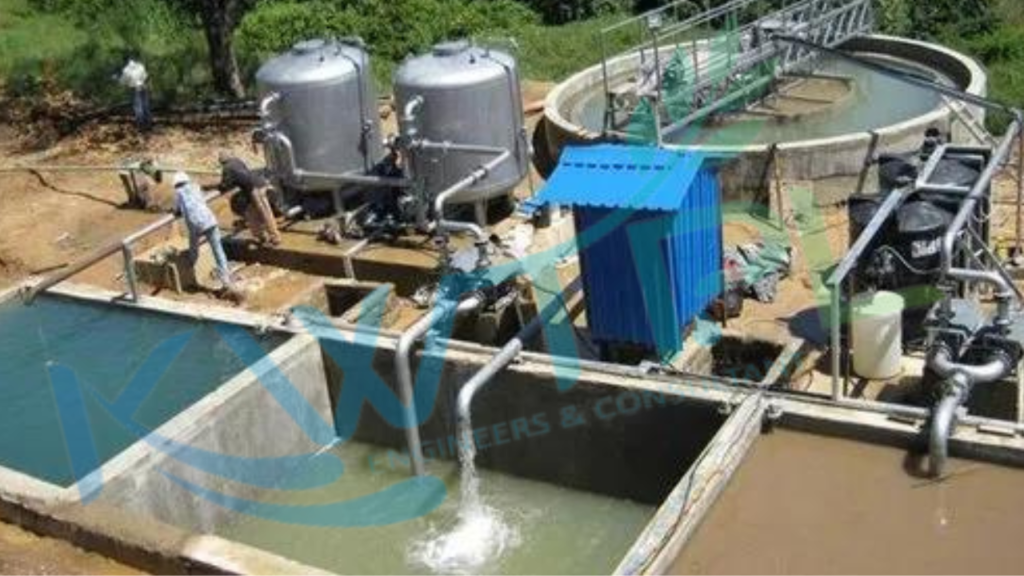What is Effluent Treatment Plant & ETP Plant Working Process

What is Effluent Treatment Plant?
An Effluent Treatment Plant is a vital tool for treating wastewater. It’s especially useful in industries like pharmaceuticals, textiles, and chemicals which commonly have water contamination concerns. This sort of plant plays a significant role in purifying both domestic sewage and industrial effluents; organic matter, inorganic matter, heavy metals, oil & grease, suspending particles, and other contaminants can all be dealt with through various forms of treatment such as chemical treatment, biological treatment, or thermal treatment.
How Effluent Treatment Plant Works?
Screening
The incoming wastewater is first passed through screens to remove large debris and solid particles like plastics, papers, and other materials that could clog or damage downstream treatment processes.
Equalization
In this step, the effluent may be mixing and homogenized to create a consistent flow with uniform pollutant concentrations. This helps in maintaining stable treatment conditions throughout the process.
Primary Treatment:
During this stage, heavier suspended solids settle out of the wastewater due to gravity in a sedimentation tank or clarifier. This process reduces the organic load and solid content of the wastewater.
Secondary Treatment
- Biological Treatment: Many ETPs use biological processes, such as activated sludge or trickling filters, to promote the growth of microorganisms that can break down organic pollutants in the wastewater.
- Aeration: Oxygen is often suppling to the wastewater in aeration tanks to support the growth of aerobic bacteria that further break down organic matter.
- Settling: After the biological treatment, the mixture of wastewater and microorganisms is allowing to settle, with the resulting sludge being separated from the treated water.
Tertiary Treatment
Depending on the required effluent quality and regulations, additional treatment steps may be employed, such as chemical coagulation, flocculation, and advanced filtration methods to further reduce remaining impurities.
Disinfection
Before the treated effluent is discharging, it’s often disinfecting to kill any harmful microorganisms. Chlorination, UV radiation, or other disinfection methods may be using.
Sludge Treatment and Disposal:
The sludge generating from various treatment processes needs to be managed. It can undergo further treatment, such as digestion or dewatering, to reduce its volume and environmental impact. Final disposal methods might include landfills, incineration, or agricultural use if the sludge is deemed suitable.
Monitoring and Compliance
Throughout the process, the quality of the treated water is constantly monitoring to ensure it meets the requiring standards set by regulatory authorities. Records are maintaining to demonstrate compliance.
Benefits of Effluent treatment plant
- Environmental Protection
ETPs significantly reduce the pollution and contamination of natural water bodies by treating industrial effluents before discharge. This helps maintain the quality of water resources, preventing harm to aquatic ecosystems, wildlife, and human health.
Public Health
Treating industrial wastewater before release prevents the spread of diseases and pathogens that can be present in untreated effluents. This is particularly important when wastewater is using for agricultural or recreational purposes downstream.
Sustainable Practices
ETPs contribute to sustainable industrial practices by minimizing the negative impact of industrial operations on the environment. This aligns with corporate social responsibility (CSR) initiatives and enhances the reputation of companies.
Improved Community Relations
Industries that demonstrate a commitment to environmental protection through ETPs can foster positive relationships with surrounding communities, reducing the potential for conflicts and opposition from residents.
Reduced Soil Contamination
When untreated effluents are discharging onto land, they can lead to soil contamination and negatively impact agricultural productivity. ETPs prevent this type of contamination and help maintain soil health.
Long-term Cost Savings
While implementing and operating an ETP involves an initial investment, it can lead to significant cost savings in the long run. Avoiding fines, penalties, and potential legal actions due to non-compliance can far outweigh the costs of establishing an effective treatment system.
Job Creation
ETPs create employment opportunities for professionals skilled in environmental engineering, water treatment, monitoring, and maintenance.
Global Sustainability Goals
ETPs contribute to global sustainability goals by conserving water, reducing pollution, and supporting responsible industrial practices, as outlined in initiatives like the United Nations Sustainable Development Goals.
Disadvantages of Effluent Treatment Plant
High Initial Investment
One of the main drawbacks of an effluent treatment plant (ETP) is the high initial investment requiring for its setup. The cost involved in purchasing and installing the necessary equipment, as well as constructing the plant itself, can be significant. This may deter some businesses from implementing an ETP.
Ongoing Operational Costs
In addition to the upfront costs, there are also ongoing operational expenses associated with running an ETP. These include electricity bills, maintenance costs, and chemical usage for treating the effluent. These recurring expenses can sometimes be a burden on businesses’ budgets.
Skilled Workforce Requirement
Operating an ETP requires skilled personnel who are knowledgeable about wastewater treatment processes and techniques. Finding and hiring such individuals may pose a challenge for some companies, especially in areas where there is a shortage of qualified professionals in this field.
Limited Efficiency for Certain Contaminants:
While ETPs are effective at removing many pollutants from wastewater, they may not be able to eliminate certain complex contaminants completely. Some industrial effluents contain specific chemicals or substances that require specialized treatment methods beyond what a standard ETP can provide.
Environmental Impact during Maintenance
Routine maintenance activities carried out on an ETP can result in temporary disturbances to nearby ecosystems due to water discharges or odorous emissions from sludge handling processes. Although these impacts are usually minimal and regulated by environmental authorities, they still need to be considered during operation.
Conclusion
Effluent treatment plant, or ETPs, play a crucial role in maintaining environmental sustainability by treating and purifying wastewater. These plants utilize various physical, chemical, and biological processes to remove contaminants from industrial effluents before they are discharging into water bodies.
By effectively removing pollutants such as organic matter, suspended solids, heavy metals, and toxins from wastewater, ETPs help protect the ecosystem and ensure the availability of clean water for future generations. The treated effluent can also be reusing for non-potable purposes like irrigation or industrial processes.